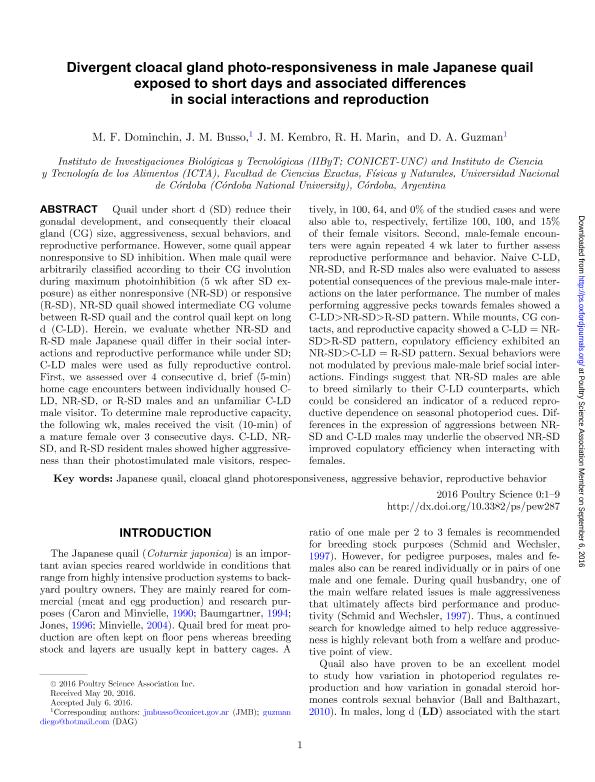Mostrar el registro sencillo del ítem
dc.contributor.author
Dominchin, Maria Florencia

dc.contributor.author
Busso, Juan Manuel

dc.contributor.author
Kembro, Jackelyn Melissa

dc.contributor.author
Marin, Raul Hector

dc.contributor.author
Guzmán, Diego Alberto

dc.date.available
2017-09-14T20:57:47Z
dc.date.issued
2017-01
dc.identifier.citation
Dominchin, Maria Florencia; Busso, Juan Manuel; Kembro, Jackelyn Melissa; Marin, Raul Hector; Guzmán, Diego Alberto; Divergent cloacal gland photo-responsiveness in male Japanese quail exposed to short days and associated differences in social interactions and reproduction; Oxford University Press; Poultry Science; 96; 1; 1-2017; 5-13
dc.identifier.issn
0032-5791
dc.identifier.uri
http://hdl.handle.net/11336/24314
dc.description.abstract
Quail under short d (SD) reduce their gonadal development, and consequently their cloacal gland (CG) size, aggressiveness, sexual behaviors, and reproductive performance. However, some quail appear nonresponsive to SD inhibition. When male quail were arbitrarily classified according to their CG involution during maximum photoinhibition (5 wk after SD exposure) as either nonresponsive (NR-SD) or responsive (R-SD), NR-SD quail showed intermediate CG volume between R-SD quail and the control quail kept on long d (C-LD). Herein, we evaluate whether NR-SD and R-SD male Japanese quail differ in their social interactions and reproductive performance while under SD; C-LD males were used as fully reproductive control. First, we assessed over 4 consecutive d, brief (5-min) home cage encounters between individually housed CLD, NR-SD, or R-SD males and an unfamiliar C-LD male visitor. To determine male reproductive capacity, the following wk, males received the visit (10-min) of a mature female over 3 consecutive days. C-LD, NRSD, and R-SD resident males showed higher aggressiveness than their photostimulated male visitors, respectively, in 100, 64, and 0% of the studied cases and were also able to, respectively, fertilize 100, 100, and 15% of their female visitors. Second, male-female encounters were again repeated 4 wk later to further assess reproductive performance and behavior. Naive C-LD, NR-SD, and R-SD males also were evaluated to assess potential consequences of the previous male-male interactions on the later performance. The number of males performing aggressive pecks towards females showed a C-LD>NR-SD>R-SD pattern. While mounts, CG contacts, and reproductive capacity showed a C-LD = NRSD>R-SD pattern, copulatory efficiency exhibited an NR-SD>C-LD = R-SD pattern. Sexual behaviors were not modulated by previous male-male brief social interactions. Findings suggest that NR-SD males are able to breed similarly to their C-LD counterparts, which could be considered an indicator of a reduced reproductive dependence on seasonal photoperiod cues. Differences in the expression of aggressions between NRSD and C-LD males may underlie the observed NR-SD improved copulatory efficiency when interacting with females.
dc.format
application/pdf
dc.language.iso
eng
dc.publisher
Oxford University Press

dc.rights
info:eu-repo/semantics/openAccess
dc.rights.uri
https://creativecommons.org/licenses/by-nc-nd/2.5/ar/
dc.subject
Japanese Quail
dc.subject
Cloacal Gland Photoresponsiveness
dc.subject
Aggresive Behavior
dc.subject
Reproductive Behavior
dc.subject.classification
Bioquímica y Biología Molecular

dc.subject.classification
Ciencias Biológicas

dc.subject.classification
CIENCIAS NATURALES Y EXACTAS

dc.title
Divergent cloacal gland photo-responsiveness in male Japanese quail exposed to short days and associated differences in social interactions and reproduction
dc.type
info:eu-repo/semantics/article
dc.type
info:ar-repo/semantics/artículo
dc.type
info:eu-repo/semantics/publishedVersion
dc.date.updated
2017-09-06T19:41:29Z
dc.identifier.eissn
1525-3171
dc.journal.volume
96
dc.journal.number
1
dc.journal.pagination
5-13
dc.journal.pais
Reino Unido

dc.journal.ciudad
Oxford
dc.description.fil
Fil: Dominchin, Maria Florencia. Consejo Nacional de Investigaciones Científicas y Técnicas. Centro Científico Tecnológico Conicet - Córdoba. Instituto de Investigaciones Biológicas y Tecnológicas. Universidad Nacional de Córdoba. Facultad de Ciencias Exactas, Físicas y Naturales. Instituto de Investigaciones Biológicas y Tecnológicas; Argentina. Consejo Superior de Investigaciones Científicas. Instituto de Ciencia y Tecnologia de Alimentos y Nutrición; España
dc.description.fil
Fil: Busso, Juan Manuel. Consejo Nacional de Investigaciones Científicas y Técnicas. Centro Científico Tecnológico Conicet - Córdoba. Instituto de Investigaciones Biológicas y Tecnológicas. Universidad Nacional de Córdoba. Facultad de Ciencias Exactas, Físicas y Naturales. Instituto de Investigaciones Biológicas y Tecnológicas; Argentina. Consejo Superior de Investigaciones Científicas. Instituto de Ciencia y Tecnologia de Alimentos y Nutrición; España
dc.description.fil
Fil: Kembro, Jackelyn Melissa. Consejo Nacional de Investigaciones Científicas y Técnicas. Centro Científico Tecnológico Conicet - Córdoba. Instituto de Investigaciones Biológicas y Tecnológicas. Universidad Nacional de Córdoba. Facultad de Ciencias Exactas, Físicas y Naturales. Instituto de Investigaciones Biológicas y Tecnológicas; Argentina. Consejo Superior de Investigaciones Científicas. Instituto de Ciencia y Tecnologia de Alimentos y Nutrición; España
dc.description.fil
Fil: Marin, Raul Hector. Consejo Nacional de Investigaciones Científicas y Técnicas. Centro Científico Tecnológico Conicet - Córdoba. Instituto de Investigaciones Biológicas y Tecnológicas. Universidad Nacional de Córdoba. Facultad de Ciencias Exactas, Físicas y Naturales. Instituto de Investigaciones Biológicas y Tecnológicas; Argentina. Consejo Superior de Investigaciones Científicas. Instituto de Ciencia y Tecnologia de Alimentos y Nutrición; España
dc.description.fil
Fil: Guzmán, Diego Alberto. Consejo Nacional de Investigaciones Científicas y Técnicas. Centro Científico Tecnológico Conicet - Córdoba. Instituto de Investigaciones Biológicas y Tecnológicas. Universidad Nacional de Córdoba. Facultad de Ciencias Exactas, Físicas y Naturales. Instituto de Investigaciones Biológicas y Tecnológicas; Argentina. Consejo Superior de Investigaciones Científicas. Instituto de Ciencia y Tecnologia de Alimentos y Nutrición; España
dc.journal.title
Poultry Science

dc.relation.alternativeid
info:eu-repo/semantics/altIdentifier/doi/http://dx.doi.org/10.3382/ps/pwe287
dc.relation.alternativeid
info:eu-repo/semantics/altIdentifier/url/https://academic.oup.com/ps/article-abstract/96/1/5/2706290/Divergent-cloacal-gland-photo-responsiveness-in
Archivos asociados
